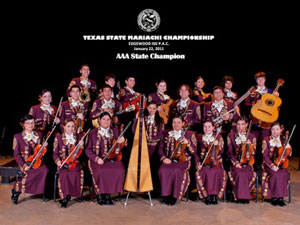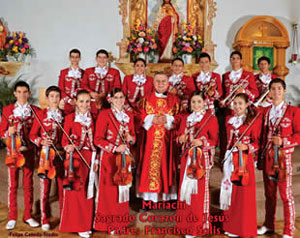
SAN ANTONIO (AP) - Most Americans probably associate mariachi music with Mexican restaurants, not classrooms - but that's changing.
Schools from Oregon to Iowa to Tennessee now teach it as an art form. San Antonio, a city that plays it at the drop of a sombrero for civic events, weddings, or funerals, long has led the way: teaching it in classrooms stretching from elementary school to college for a degree program in mariachi.
Some observers say it preserves the tradition and exposes it to new audiences; others see it as a way to engage Latino students. Generally, students can only study mariachi if their grades are in good standing.
But the growing interest is not restricted to just Latinos. This year, North East Independent School District added its first mariachi class ever at a middle school, attracting some Anglo and African American students.
Mariachi traces its roots to 19th-century Mexico. Its presence in San Antonio schools dates back more than four decades. The city's largest program, in the San Antonio Independent School District, started in 1970, and is often cited as a template for other school districts in the Southwest.
Mariachi used to be considered, even by Latinos who looked down on it, as cantina music - and now look at it," said Belle Ortiz, who helped start SAISD's program and designed mariachi curriculum used in many South Texas schools. "We were among the first to recognize it here."
Today, the program teaches mariachi to about 2,600 students in 18 schools. Nine other local school districts also offer it.
Mariachi is best known for its jubilant, boisterous sound - its lyrics often about soaring love that, at times, dramatically crashes down, punctuated by instruments such as the guitarrón and vihuela. Musicians are usually dressed in a "traje de charro": a dressy cowboy suit that includes pants adorned with silver button-like studding on the sides, a bolero jacket and the moño, a fluffy bow tie.
San Antonio's mariachi education community is interconnected and tight-knit. Many know Belle Ortiz and her Grammy award-winning husband, Juan, not only as the godparents of mariachi education, but as the leaders of Mariachi Campañas de America, an ensemble that has played at the White House and modernized the genre by covering pop songs from artists such as Adele.
But a new generation of teachers, having come out of local mariachi programs, is returning to neighborhood schools. Coincidentally enough, another married couple, Cirilo and Angela Campos, embodies the trend.
Both in their late 20s, they played professionally, were among the first to get master's degrees in music education with a specialty in mariachi offered at Texas State University and returned to their old schools to teach.
Cirilo Campos teaches at Irving Middle School in SAISD, while Angela Campos shepherds NEISD's first-ever program at Wood Middle School, a class that started a few years ago as an after-school group.
 "I tell the kids how it's a program that helped save me from some of the perils of the barrio," Cirilo Campos said, adding that he used money earned as a mariachi to fund his education. "I've been to Germany, Switzerland, Morocco, because of mariachi. And those stories help students see its potential in their lives."
"I tell the kids how it's a program that helped save me from some of the perils of the barrio," Cirilo Campos said, adding that he used money earned as a mariachi to fund his education. "I've been to Germany, Switzerland, Morocco, because of mariachi. And those stories help students see its potential in their lives."
It's not lost on students such as Bianca Beltran, 13, an eighth-grader who plays trumpet.
"It helps me a lot in staying on track in my classes," she said. "It also makes me feel like I am part of a group, something that's important and keeps a tradition alive in our community."
During practice on a recent afternoon, almost 50 students jammed the classroom, some of them attempting the grito, the half-laugh/half-sob that mariachis shriek to underscore the passion of a song. The effects of puberty on male voice boxes could be detected with cracked crescendos here and there, but the female students weren't shy about giving it a try, either.
The class at Wood, at less than half that size, is working to prove the program's worth and expand it to high schools. It's partly funded by NEISD but the group is raising money for new trajes like any mariachi would: by performing.
"Some people think it's cool, others think it's lame, but we like the kind of music. It's fun," said Mario Morado, 12, a seventh-grader who plays the guitarrón.
A reach beyond S.A.
Mariachi's "cool" factor has pinged loudly on the nation's pop culture radar.
Lady Gaga sang her hit "Born This Way" with mariachis in a viral video last year. And Prince Royce, a Dominican-American musician popular with Latino youths, fused the genre with his trademark bachata-style music in one of this year's biggest hits on the Billboard charts.
Add to that this year:
- The PBS documentary, "Mariachi High," focused on students in the Texas border town of Zapata.
- An episode of NBC's "The Voice" featured mariachi Julio Cesar Castillo.
- The rock band Train incorporated mariachi into one of its hits.
- Fashion designer Michael Kors dressed as a mariachi this past Halloween.
And jaws dropped as Americans heard the voice of San Antonio mariachi Sebastien De La Cruz, a Salinas Elementary School student who floored critical judges on NBC's "America's Got Talent."
Like many of his peers, De La Cruz honed his craft through large contests often held in San Antonio, arguably as much the capital of student mariachi as it is for Tejano music. Two of the longest-running such events in the United States are the Texas High School Mariachi Competition, held in the Edgewood Independent School District, and Mariachi Vargas Extravaganza here.
Oddly enough, the genre has languished in Mexico, where schools have been opened to nourish the art form. But San Antonio essentially has become a factory of sorts for mariachis, Belle Ortiz said. Students can study the music from elementary school up to Texas State or Palo Alto College, the community college here whose mariachi certification program she and Juan Ortiz designed.
The business community also is embracing mariachi. The San Antonio Hispanic Chamber of Commerce this year started its Corazón de Mariachi fundraiser for scholarships, featuring University of Texas at San Antonio President Ricardo Romo, City Councilman Cris Medina and other officials singing live with Campañas de America.
"When presidents and dignitaries are brought to San Antonio, it's not Tejano or country music that usually welcomes them, it's mariachi," Juan Ortiz told the crowd at a chamber event.
As schools struggle with funding cuts, opposition to the classes has barely registered, district administrators said. On one occasion, a resident at an Edgewood ISD board meeting this summer did call the program "un-American."
 But even the Texas governor's office has jumped on the mariachi bandwagon, offering bookings of student groups on its Texas Music Office website.
But even the Texas governor's office has jumped on the mariachi bandwagon, offering bookings of student groups on its Texas Music Office website.
Casey J. Monahan, the office's longtime director, said he hasn't heard any criticism of that support.
"Quite the opposite," he said. "Once you are a music lover, it is a lifetime way of thinking that crosses genres."
Wood Middle seventh-grader Cassie Eakle, 12, agrees. She views mariachi as any other kind of music, blazing her own trail as a non-Latino learning the craft.
"People are like, 'What? A blond girl with blue eyes singing mariachi?'" said Eakle, a violinist. "All the words I am singing, I can pronounce, but I don't know what they mean. But my dad brags all the time, 'My daughter's a mariachi.'"
Her bandmate, Morado, interjected, "Yeah, she's the one who gets the crowd going."
Copyright 2012 The Associated Press.
